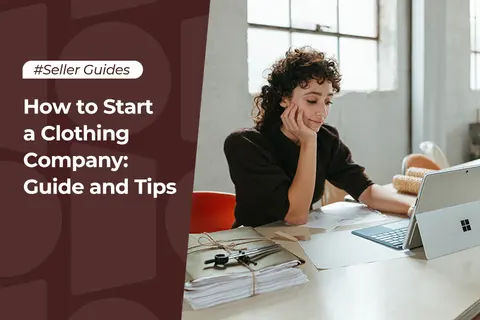How to Start a Clothing Company: Guide and Tips

Table of Contents
Starting a clothing company is no simple task; it takes both creativity and business acumen to make the corporation work. A creative plan serves as a roadmap for the clothing company, guiding the design process, brand identity, and marketing efforts. It fosters creativity, consistency, and innovation while ensuring that the brand resonates with its target audience and stands out in the competitive fashion industry.Here's a comprehensive guide to help you navigate through the process:
Find Your Clothing Brand
The fashion industry is massive, consisting of a range of different brands–all with various styles and niches. It’s important to identify your band place and stick to it. This will help you to create a product line that resonates with your target market and build a solid brand. Here are a few examples of highly successful clothing brands that operate in different niches: Casual, Athletic, Trendy, and Classic.
Picking a proper brand place means playing to your strengths. If you’re a strong semester student, you’ll spend most of your time designing and constructing products. If you’re a brilliant artist, you might create art that can be printed on T-shirts or other clothing items.
Know Your Exact Audience
It’s important to figure out your ideal customer. When you’re working towards establishing your business, fashion makes things both easier and harder at the same time. You can easily imagine who would wear your clothes, but you also have to find where they congregate and how to reach them.
Here are a few questions to consider when determining your audience:
- Who are they?
- What are their favorite clothing brands?
- Do they identify with certain brands?
- Where do they shop?
By answering these questions, you will get a better understanding of your target audience. This enables you to more strategically build your brand, develop products they’ll want, and distribute products so they’re easily discoverable by the people who will buy them.
Create a Clothing Business Plan
After defining your niche and identifying your audience, the next step is to put together a marketing plan. While it sounds like a lot of work–it doesn’t have to be very comprehensive. But you do need to detail which channels you plan to use to sell your products, such as direct, Amazon, Etsy, boutiques and big box stores, or other online shopping websites, as well as how you plan to market your businesses and select the best vintage clothing websites so that you get sales.
Here’s are the must-haves when creating a new business marketing plan:
- Market and competition
- Distribution channels
- Marketing strategy
- Marketing budget
A marketing plan essentially establishes how you will market your clothing line, and with that, can greatly guide how you go about product distribution and advertising strategies, which will impact your sales. Learn more about
Find a Clothing Manufacturer
Depending on your requirements and personal situation, there are three main categories of clothing production.
Some factories will simply assemble materials that you provide, whereas others will help with the designing process, creating patterns and sourcing materials too. You can also build a shopify app to search more clothing manufacturers.
The most common garment manufacturing options are: –
- Cut, Make, Trim (CMT)
- Full Package Production (FPP)
- Print On Demand (POD)
What is Cut, Make, Trim (CMT) Manufacturing?
A CMT manufacturer works as per the acronym; they cut the fabric, make up the garments and finish them with the provided trimmings such as zips and buttons. On the face of it, this seems like a great solution, however, CMT includes only the physical making of the garments.
A CMT manufacturer wouldn’t assist with the design process or supply materials, meaning you have to provide absolutely everything to them. CMTs usually charge an hourly rate, as opposed to charging per garment. This works well for them because their manufacturing is purely time-based, with them making money on the amount of time it takes to make a piece. Due to this, there is usually no minimum order quantity (MOQ).
A CMT will usually be happy to make 1 or 100 units, because either way they’re being paid for their time. CMTs are often favored by independent designers who only produce very small runs of garments, and who wouldn’t be able to work with the MOQs of other manufacturers.
Services Provided by CMTs:
- Basic pattern development
- Fabric cutting
- Fabric stitching
Pros of CMT:
- Usually have no minimum order quantities
- High quality control measures
- Fully customisable
Cons of CMT:
- Main feature: Expensive
- Unable to grow alongside the business due to their limited workforce
- It’s time-consuming and complicated for startup brands
What is Full Package Production (FPP)?
Full Package Production is the term used to describe the type of production whereby the manufacturer handles the entire process. They provide the “full package”, with the manufacturer guiding the client through every step of the process from an initial meeting or design brief, right through to delivery.
Some FPP manufacturers also offer design services, however most can produce an initial sample from reference images and text descriptions, with the bulk items being developed from the sample.
FPP manufacturers tend to have fabric expertise and are able to offer advice and guidance as to what fabric would be suitable for specific applications.
This type of manufacturing is most suited to those brands who are looking to outsource the whole process to a third party whose expertise is in producing fully custom products, most likely because they’re new to the industry or looking to have more involvement with the branding side of their clothing line. This is by no means a hands-off approach though; the FPP manufacturer will be in constant contact with the client to ensure that all of their specifications are well understood.
The main disadvantage to FPP manufacturers is that they implement minimum order quantities (MOQs) in order to make production viable. Manufacturers differ, with some offering far lower MOQs than others. In the FPP manufacturing world, MOQs can range from just 50pcs to 1000pcs per design, so it’s best to talk to manufacturers and ask what their MOQs are right away. Some manufacturers implement MOQs not just per color, or per design, but per size. This means that some FPP manufacturers aren’t viable options for small start-up brands, however, there are start-up specialist FPPs in the industry who can help you if you’re new to the business.
What is Print On Demand (POD) Manufacturing?
With print on demand, your clothing designs are printed when you need them, instead of in bulk before you need them. They usually have low MOQs, just 1 in most cases. A print on demand business, just like every other business model, has its own set of pros and cons, the main cons being limitations when it comes to customisation.
POD manufacturers work using “stock, pre-made” garments, which have been purchased in huge bulk quantities for low prices. They will then print or embroider one of these garments with designs supplied by the customer. Although cheap, the obvious drawback of this is that the garments aren’t unique to your brand, and you have no control over the finer details.
You have no control over the sizing, style, or composition. Some offer relabelling services, however most do not, and if they do offer relabelling services, it will be expensive. Some POD manufacturers even use the labels of the stock clothing – Gildan and Fruit of the Loom for example, so any customer will know that they’re really just getting a cheap item which has been rebranded.
When it comes to POD however, they can offer some convenient services which your brand may benefit from, like drop shipping. Some POD manufacturers will take an order from yourself and deliver it directly to your customer, meaning you never have to even see the items.
Services Offered by POD Manufacturers
- Printing
- Embroidery
- Stock Garment Sourcing
- Occasional relabelling
Build Pricing And Inventory Strategies For Your Clothing Business
On the less creative side of running a clothing business, you’ll need to establish some strategies to help keep your back office in order. This includes setting pricing strategies and inventory management practices.
Pricing Your Clothing Line
Pricing your clothing items involves the same exercise as pricing any item for sale. You’ll need to consider costs to produce, market, and ship the product, as well as any overhead for running the business. Look also to the market to see what consumers are willing to pay, like women's shein clothing, for a brand like yours.
Inventory for Clothing Businesses
Managing inventory is a delicate process for any business. Clothing won’t spoil like perishable products, but trends move quickly. Work with your data to understand what’s selling and what isn’t, and tweak your production and design cycles accordingly. This way, you won’t end up sitting on unsellable stock.
If you ship your own orders, establish an inventory system that keeps clothing protected from sunlight and moisture, and organized in a way that makes it easy to find.
Market Your Clothing Company
Marketing and driving sales remain the single most reported challenge for online brands, regardless of industry. As fashion is a saturated market, developing a solid brand will help you focus your efforts on your ideal customer rather than throwing money away.
In the beginning, your budget will be small, but there are still ways to grab attention with creative and organic ideas:
- Invest in content marketing. Use optimized video or keyword-targeted blog posts to drive traffic to your site.
- Build an email list even before you launch. Tease your upcoming clothing collection on social and incentivize sign-ups with exclusive deals.
- Lend your clothing to other businesses for photo shoots to get shoutouts and exposure.
- Find collaborations. You can collaborate with complementary brands to launch a collection, pop-up, co-promotion.
- Learn search engine optimization (SEO). Honing your SEO skills can help you drive traffic to your online clothing store.
- Try social media advertising. This can include paid ads, promoted posts with creators, and even organic content with viral potential.
As you grow, applying to show your clothing line at smaller Fashion Week events are all ways to gain exposure for your brand.
Conclusion:
Starting a clothing business is a great way to merge creative passion and business sense. It also gives you the opportunity to see your artistic work on people on the street, while turning your passions into a profitable business. Now that you know how to start a clothing business, you’re ready to act on step one! As you prepare to launch your own clothing brand, and enter the competitive fashion industry, remember to focus both on what makes your ideas unique and what your target customers want.
Start your borderless business here
Tell us about your business and stay connected.
Keep up with the latest from Alibaba.com?
Subscribe to us, get free e-commerce tips, inspiration, and resources delivered directly to your inbox.















